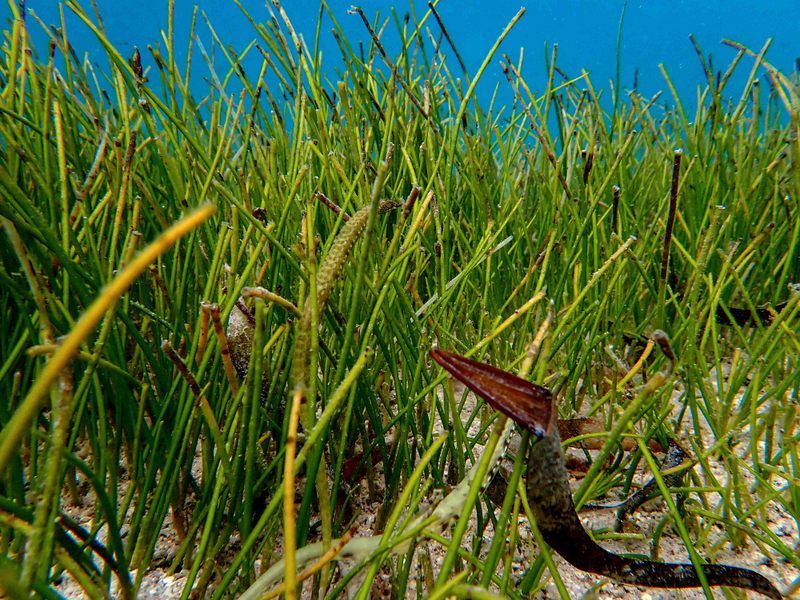A collage of seaweeds grass and twigs rooted in the sand in the South of Mauritius. Photo : Jacques Achille
A dive into the sea of Bel Ombre rewards any visiting snorkeler with a rare and beautiful sight.
Some 10 metres from the shore, in the clear waters of this fisher village located in the south of Mauritius, lush green beds of slender grass appear to blow in the breeze as the current moves through them.
Whether the sea is calm or rough, the seagrass remains rooted in the sand, unbowed, providing sanctuary and food for a whole ecosystem of fish, invertebrates, crabs, sea cucumbers and even large mammals — like the nearly extinct dugong, or manatee.
While seaweeds grow mostly on rocks and corals, seagrass anchors in the sand. There is a wide variety of species, each creating a unique biome.
“Above all, each has its own importance and ecosystem,” explained seagrass researcher Olivier Pasnin.
Seagrasses act as the lungs of the ocean. “They release oxygen into the sea. They also help in enhancing the quality of air and fighting global warming. These plants are among the main wells of carbon on earth. They can retain a high quantity of carbon and keep it in the form of organic carbon in sediments for a long period,” said Pasnin.
But the beds of critical aquatic plants, once a ubiquitous feature of the littoral zone of the Indian Ocean islands and the African mainland, are in grave danger.
“The field is smaller than it was some years back. It seems to be affected by human activities and climate change. As a direct consequence, there are fewer fish. We have to go further in the sea to work now,” said Adrien Robert, who has been a fisher for most of his 54 years.
While Robert provided the alarming empirical knowledge, Pasnin provided the even-more-worrying hard data.
“It is estimated that every hour the world is losing the equivalent of two football pitches of seagrass,” he said.
 A collage of seaweeds grass and twigs rooted in the sand in the South of Mauritius. Photo : Jacques Achille
A collage of seaweeds grass and twigs rooted in the sand in the South of Mauritius. Photo : Jacques Achille
Yet, as global warming accelerates the process of coastal erosion in Mauritius and overfishing places pressure on fish stocks, seagrass is seen as a solution. Its presence brings along fish to the waters of the region, feeding the herbivores and providing protection to smaller marine animals eaten by bigger carnivores.
So the local fisher community turned to scientists for help.
“They reported to us that the fields of seagrass are permanently changing and becoming smaller. This is why we have started to study them more closely so as to assess the situation and to be able to act accordingly,” said Pasnin, explaining how he joined efforts to replant seagrass through the Reef Conservation Society, which was previously concerned mostly with dying coral reefs.
The community, supported by the conservationists, is now working to bring the beds of seagrass back.
According to Pasnin, they are concentrating on replanting five species of seagrass, which are common in the Bel Ombre area as well as in the sea off Roche Noire, in northeast Mauritius.
“Our team embarked on the project to save the coastal zone with research and educating the local fisher community on the importance of being part of the initiative in 2021 with funding from the European Commission,” Pasnin said.
Mauritian enterprises are now also supporting the Reef Conservation Society. One of them is the Oxenham Group, which in August 2022 launched a programme under the aegis of the Islander’s Preservation Action, aimed at educating the general public and supporting groups involved in the restoration of the marine ecosystem, through the replanting of seagrass and coral reefs.
In a document presenting the project, the Reef Conservation Society explains that different techniques are being trialled with different species of seagrasses to develop the best methodology for larger restoration projects.
“In this project, we have also included stakeholders and community members through practical actions that help build understanding, a relationship with nature and support the conservation and management of seagrasses,” the society notes.
During November, conservation experts from the Södertörn University of the World Maritime University of Switzerland are expected to arrive to give international impetus to the project.
“We are very much concerned about what is happening in our sea,” said Robert.
“We want to save the ocean, fight coastal erosion and create proper conditions for fish to live in our water. It is also a question of survival for us.” — bird story agency